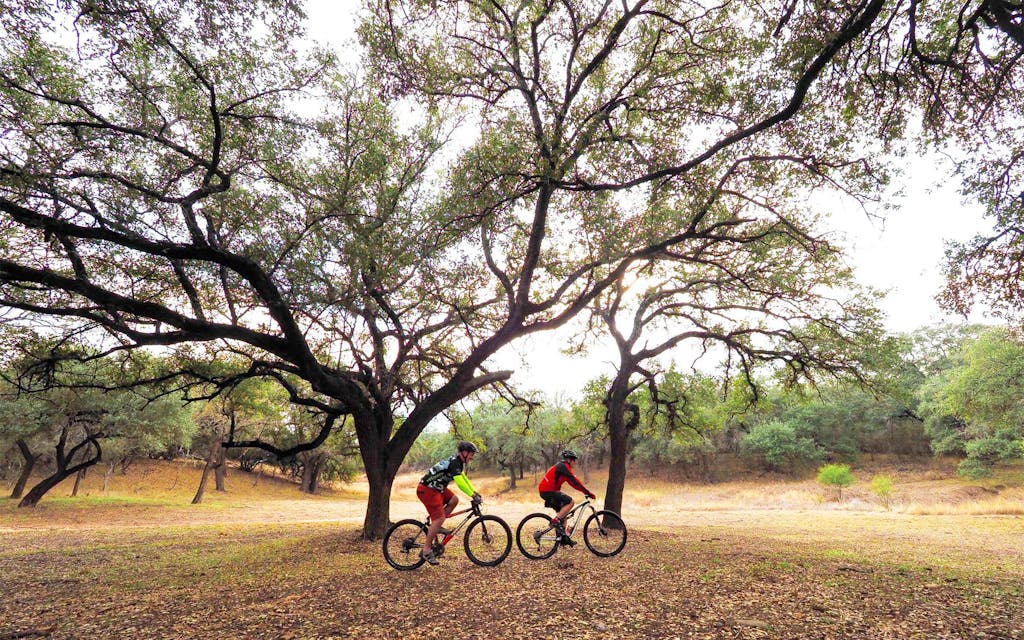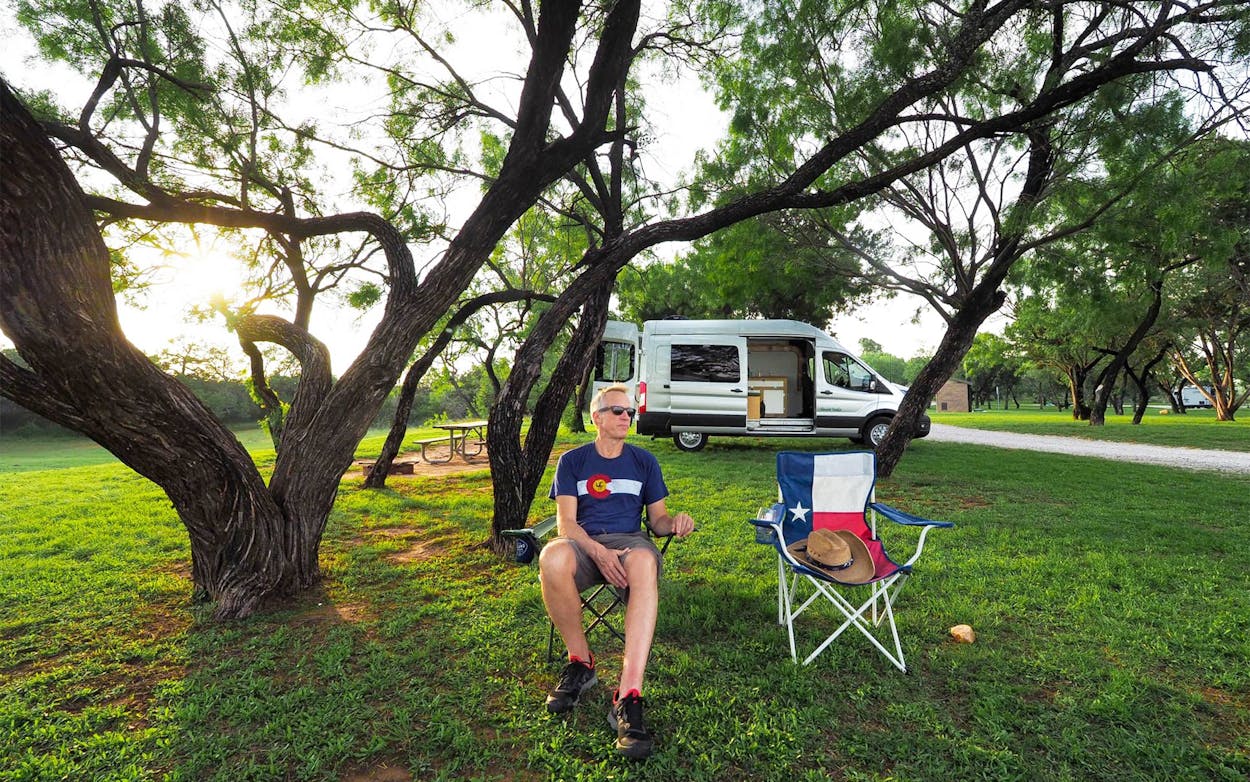Fresh off a ninety-minute hike that led me down a rocky hillside, past the crumbling remains of an old stone chimney, and onto a sandy beach along Lake Travis, just east of Marble Falls, I ease myself into a steamy outdoor tub and tip back my head. Dang, I think. Parks have gotten fancy.
As I recall, Texans once visited parks simply to do typical outdoorsy stuff: hike, pitch a tent, jump in a river, and maybe grill up a few burgers. But at a string of Lower Colorado River Authority (LCRA) parks, including Shaffer Bend Recreation Area, where I lolled like a dumpling in a soup pot, that’s just the starting point.
The LCRA produces and delivers electric power and manages roughly six hundred miles of the Colorado River. The nonprofit public utility also operates 42 public parks between San Saba and Matagorda Bay, roughly following the trajectory of the river. That’s almost 11,000 acres of parkland to explore. While some of these parks, such as Lake Bastrop, lack the marquee attractions that Instagram-minded travelers may be expecting when they head to Enchanted Rock State Natural Area or Pedernales Falls State Park, that’s all the better when it means you’re rewarded with peace, quiet, and fabulous amenities. At LCRA parks, visitors can zoom over a wide valley on a zip line, play miniature golf, or take an archery class.
And while you can still hike, camp, swim, or grill burgers in LCRA’s parks, you can also book a night in a luxurious safari-style tent, a shiny Airstream trailer, or a cabin. While those glamping options can get expensive, day use is just $5 for adults, $2 for seniors and those with disabilities, and free for children twelve and under. Tent camping costs about $25 a night, and sites with hookups are about $20 more, depending on the park.
Crucially, LCRA parks are much lesser-known and less visited than Texas’s beloved but overburdened state parks. Annual visitation for LCRA’s facilities was about 1.5 million visitors in 2023, versus TPWD’s more than 9.2 million. When I visited Shaffer Bend in February, my husband and I were the sole overnight guests.
By contrast, booking a campsite for a weekend visit to many of Texas Parks and Wildlife’s most popular destinations, such as Ray Roberts Lake State Park or Enchanted Rock, often requires months of advance planning (and no small amount of luck). Not so with LCRA. If you’re dreaming of a last-minute weekend getaway or a quiet, uncrowded campground, these underrated parks may be just the places to look. Also important? All LCRA parks, and their assorted accommodations, are pet-friendly.
LCRA has worked to to develop each park as its own distinctive destination, says Margo Richards, the group’s vice president of community resources. “Some have glamping, some have primitive camping, some have RV spots,” Richards says. “Each park has its own personality, and all of our parks are located on a body of water—the Colorado River or a tributary or a lake.” Without further ado, here are some of our tried-and-true favorites.
Jessica Hollis Park
Austin
This small, day-use-only park is located on the upper reaches of Lake Austin, just below Mansfield Dam, where chilly water flows out of Lake Travis. Early in the day during periods of hot weather, Jessica Hollis Park draws serious swimmers and triathletes out to log training time in the brisk waters. By afternoon, folks who are just looking to cool off—and take a flying leap off the low bridge—filter in.
Launch a kayak or paddleboard (they’re available for rental) from the shore, or settle in at one of the picnic tables, which require reservations on summer weekends. While it can get busy on weekends, paddling here is much more tranquil than the Party Island situation on Lady Bird Lake. Crews recently installed new shade structures, too.
Matagorda Bay Nature Park
Matagorda
If the Colorado River is a southbound train, Matagorda Bay Nature Park is its engine. Located right on the Colorado River, where it flows into the Gulf of Mexico, the park is the southernmost in LCRA’s chain of destinations. Visitors can park their own RV or camper; stay a night in a sleek, bullet-shaped Airstream trailer; or book one of ten upscale, new beach bungalows on stilts, each with a kitchen and a large deck. The RV area isn’t exactly scenic—think two paved loops with a few palm trees scattered here and there. But the bathrooms gleam, the fishing on two lighted piers is great, and it’s within easy walking distance of a sandy beach perfect for strolling.
Most folks only see the developed part of the 1,334-acre park, but you can also rent a kayak from headquarters and paddle across the Colorado River to one of the best shelling beaches in the state. Or head across the highway in the opposite direction to explore the watery kayak trails that slice through marshlands. The nature center has a small gift shop and offers organized activities such as archery for a small fee. And did we mention the miniature golf course?
McKinney Roughs Nature Park
Cedar Creek
Two thousand years ago, prehistoric hunter-gatherers camped in this area east of Austin, where four ecosystems—post oak savannah, blackland prairie, East Texas Piney Woods, and a riparian zone—converge. Today visitors come to McKinney Roughs to bike, hike, or horseback ride on eighteen miles of trails that meander through forests of loblolly pine and oak. Some also visit for the chance to scream like hyenas as they swoop over valleys on the park’s side-by-side zip lines.
Stop by the visitors center to check out exhibits that include an aquarium stocked with native species of fish, or to borrow birding binoculars, a magnifying glass for looking at plants, or a bug jar for collecting insects. The trails are beginner-friendly for cyclists—mostly dirt, without much of that sharp limestone common in Central Texas. If you don’t have your own bike, you can rent an electric mountain bike to explore on your own or book a guided tour on a utility terrain vehicle. Horses are also allowed at the 1,140-acre park. An on-site dormitory and event spaces are available for rent, but there’s no camping.

Muleshoe Bend Recreation Area
Spicewood
The bluebonnet display at Muleshoe Bend Recreation Area, where a sea of blooms so vast you could sail a ship through it arises each spring, draws in flower peepers in March and April. (This year a celebration called Bluem, on March 23, will include food, games, and other wildflower-themed activities.)
If you’re into mountain biking, put this spot on your list. A bike club called the Austin Ridge Riders built the park’s network of nearly 10 miles of biking trails, which includes the 6.5-mile Great Escape Trail. That route serves up tight turns, ledgy drops, and fast zoom-y stretches, and afterward you can wade directly into Lake Travis to cool off.
The camping’s good, too. Sites are nicely spaced along the lakefront, the grass is lush, and everyone’s within walking distance of the water. A flushing restroom and outdoor shower are located at the park entrance; nonflushing toilets are located near campsites. Check the park website for activities, which include periodic guided night hikes, when participants armed with black lights search for scorpions and spiders that fluoresce after dark.


Lake Bastrop North Shore Park
Bastrop
If you’d rather leave the tent stakes and camp setup to someone else, put this 182-acre, pine-studded property on your list. In 2018, LCRA wheeled in five shiny Airstream trailers; gave them all Texas-inspired names, such as Blue Lacy (that’s our official state dog breed); and set up firepits and seating areas around them. A few years later, it hired a company called Glat to install upscale cabins and a cluster of safari-style tents. These accommodations are all air-conditioned, making camping bearable during the hot Texas summer, and all come with a firepit and chairs out front. (The Airstreams and the cabins are equipped with bathrooms, but guests who stay in the tents use the community bathroom down the path.) For those who’d like dinner and a movie, each cabin includes an outdoor grill, a firepit, and a bubbling hot tub. You can even arrange to inflate a portable screen and watch a movie outdoors.
Nearly ten miles of trails beckon, too, including the short and snappy Buzzard Point loop, adjacent to the campground, and the longer lakeside trail that leads all the way to the south side of the lake, where LCRA has another park, Lake Bastrop South Shore Park. Or rent a kayak, paddleboard, or small fishing craft and hit the surf. Just remember that the water in Lake Bastrop, a cooling lake for a nearby power plant, is nearly as warm as what fills that hot tub, with temperatures reaching into the 90s by July.
Shaffer Bend Recreation Area
Marble Falls
Think of Shaffer Bend as a two-layer cake. From the top, you get sweeping views into the surrounding Hill Country. Take the main park road or the steep and rocky Dagger Trail down to the lower layer, which hugs the upper reaches of Lake Travis, and you’ll find sandy pocket beaches and thickets of trees. Five miles of trails cut through this 508-acre expanse, serving up mostly beginner terrain for mountain biking, hiking, or trail running. Horseback riding is allowed on several trails here. Look hard and you’ll find the crumbling remains of an old chimney and well just off the Homestead trail.
The park recently put in a luxurious, off-the-grid, safari-style tent furnished with a queen-size bed, a bathroom, and a shower, plus a microwave, a sink, and dishware. You can even arrange to have a chef cook a meal on-site or drop off a grill-it-yourself meal kit. Outside, there’s a heated “cowboy pool” (a small hot tub) and a firepit, and the two-night-minimum rental includes use of a pair of electric mountain bikes and kayaks.
For a more affordable stay, opt for one of 22 primitive campsites (2 are equipped with horse pens). We recommend site 16, which is bigger, shadier, and more secluded than the others. The park also offers utility terrain vehicle tours.
- More About:
- Parks & Recs
- Matagorda
- Marble Falls
- Bastrop






